Pranamasana: Steps, Benefits, Contraindications, and Modifications for a Balanced Yoga Practice
Soham Yoga School Rishikesh, India
Pranamasana: Introduction, How to Do It Step by Step, Benefits, and Contraindications with Modifications
Pranamasana (Prayer Pose) is one of the simplest yet most powerful yoga postures, symbolizing reverence and humility. It is often performed at the beginning and end of a yoga session, helping practitioners connect with their inner self and express gratitude. While this pose may appear simple, it holds great significance for grounding the body and calming the mind.
How to Do Pranamasana Step by Step
Starting Position:
- Stand straight on your yoga mat in Tadasana (Mountain Pose), with your feet together and arms by your side.
- Distribute your body weight evenly on both feet.
Aligning the Body:
- Lengthen your spine and relax your shoulders.
- Engage your core muscles slightly and breathe deeply.
Bringing Hands Together:
- Inhale deeply and bring your palms together in front of your chest in a Namaste gesture (Anjali Mudra). Your fingers should point upward, and your thumbs should lightly touch your sternum.
- Keep your elbows relaxed and slightly away from your torso.
Focus and Breathe:
- Close your eyes gently or keep them open with a soft gaze.
- Take slow, deep breaths, feeling a sense of peace and connection.
Final Position:
- Stay in Pranamasana for several breaths or as long as you feel comfortable.
- With each exhale, visualize releasing any tension or stress.
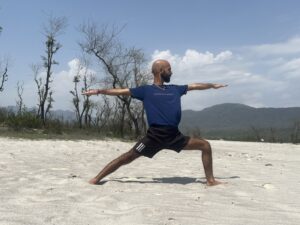 Virabhadrasana II (Warrior II Pose): A Complete Guide
Virabhadrasana II (Warrior II Pose): A Complete Guide
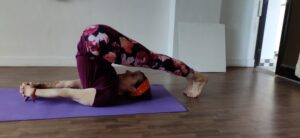
Halasana (Plow Pose): Mastering the Steps, Benefits, Contraindications, and Modifications for a Healthier Practice
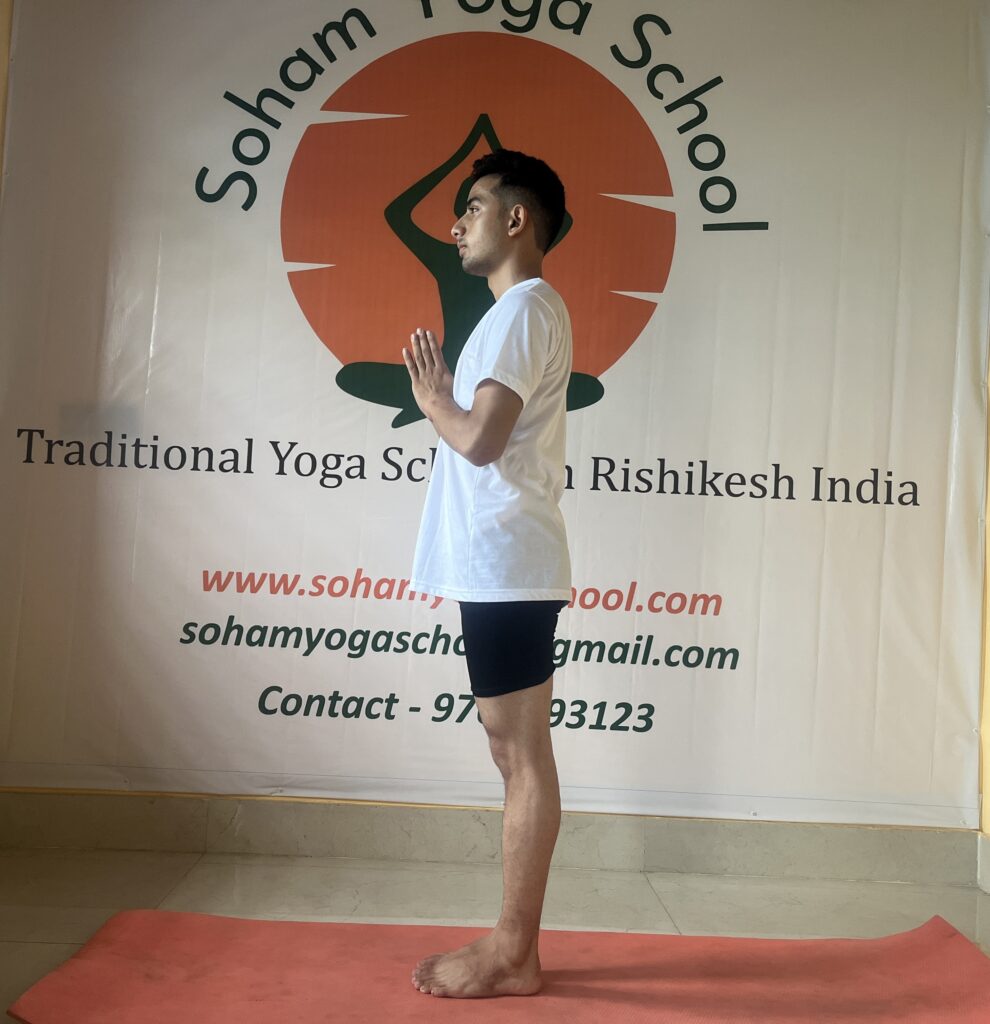
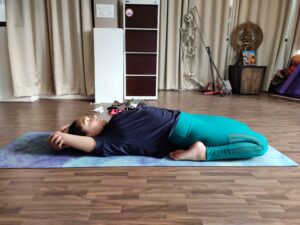 Supta Vajrasana: Introduction, How to Do It Step by Step, Its Benefits, and Contraindications with Modifications.
Supta Vajrasana: Introduction, How to Do It Step by Step, Its Benefits, and Contraindications with Modifications.
Benefits of Pranamasana
Mental and Emotional Balance:
- Pranamasana is a meditative pose that helps calm the mind, reduce stress, and foster emotional balance. The gesture of prayer promotes inner peace and mindfulness.
Enhances Focus and Awareness:
- This pose increases concentration and focus, making it a perfect starting posture for any yoga session. It encourages mental clarity and cultivates a sense of being present in the moment.
Improves Posture:
- By standing tall and lengthening the spine, Pranamasana enhances posture and aligns the body properly, helping to correct any imbalances in your stance.
Spiritual Growth:
- The prayer gesture is often associated with spiritual humility, allowing practitioners to develop gratitude and self-awareness. It deepens the connection between body, mind, and spirit.
Aids Breathing:
- When done with deep, controlled breathing, Pranamasana improves lung capacity and breath control, benefiting the respiratory system.
Relieves Anxiety:
- Practicing this pose regularly can lower levels of anxiety, promote calmness, and contribute to overall emotional well-being.
Contraindications of Pranamasana
Although Pranamasana is generally safe for most people, there are a few conditions where caution is advised:
Knee or Hip Injuries:
- Individuals with knee or hip injuries should be cautious while performing the standing aspect of this posture, as it could exacerbate pain.
Vertigo or Balance Issues:
- Those experiencing dizziness or balance problems may find it challenging to perform this pose while standing. In such cases, it can be practiced while seated.
Heart Conditions:
- While Pranamasana is a gentle pose, if you have a heart condition, it’s always advisable to consult a doctor before practicing any form of yoga.
Modifications for Pranamasana
Seated Pranamasana:
- If standing is difficult, especially for seniors or those with lower-body injuries, Pranamasana can be performed while seated in a comfortable chair or on the floor in Sukhasana (Easy Pose).
Wall Support:
- For those with balance issues, standing near a wall for support can help maintain stability and ensure comfort during the pose.
Guided Breathing with Mudra:
- To deepen the benefits of the pose, combine it with deep Pranayama (breathing exercises), such as Nadi Shodhana (Alternate Nostril Breathing), while holding the Anjali Mudra. This enhances relaxation and mental clarity.
Conclusion
Pranamasana, though simple, is an important foundational pose that carries profound benefits for the mind, body, and spirit. It serves as a gateway to deeper mindfulness, enhanced concentration, and a sense of gratitude. By practicing this pose with intention and awareness, you can develop a calm, centered state of being. Always listen to your body and make modifications as necessary to ensure a safe and comfortable practice.
Explore Our Range of Upcoming Yoga Training Courses Rishikesh
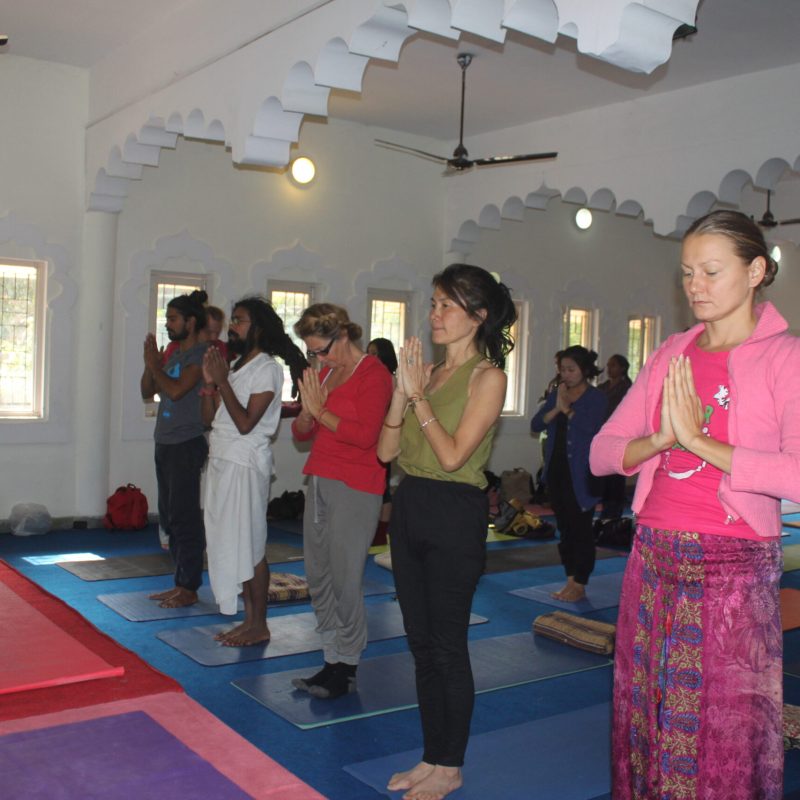
100 Hour Yoga Teacher Training in Rishikesh (India)
Duration: 14 Days
Module: Residential with Meal
Accommodation: Shared Room
Certification: Yoga Alliance USA
Course Fee: 699 USD
Yoga Style: Hatha Yoga
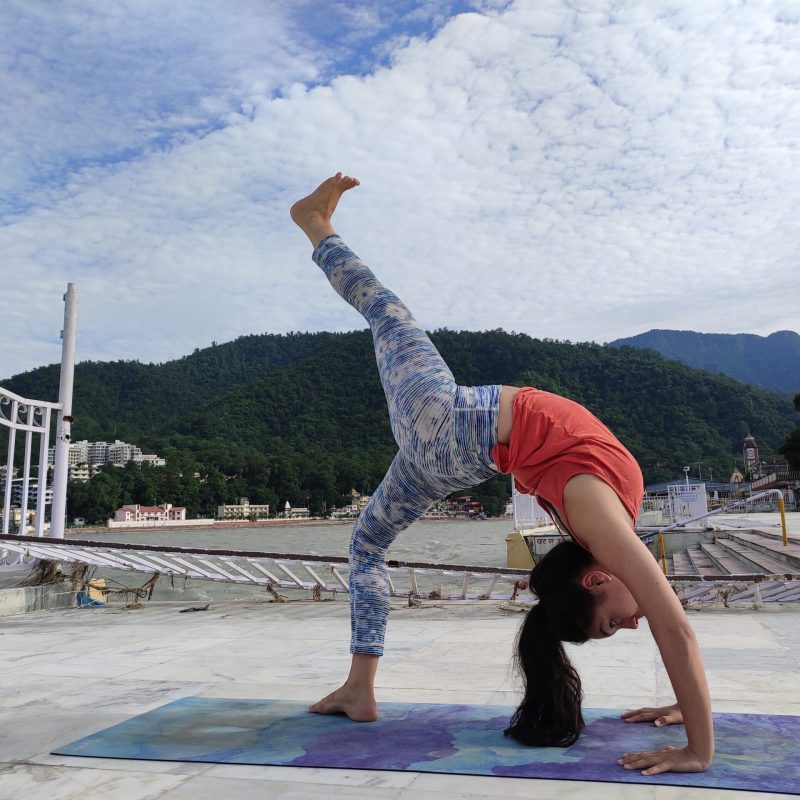
200 Hour Yoga Teacher Training in Rishikesh (India)
Duration: 25 Days
Module: Residential with Meal
Accommodation: Shared Room
Certification: Yoga Alliance USA
Course Fee: 999 USD
Yoga Style: Hatha Yoga
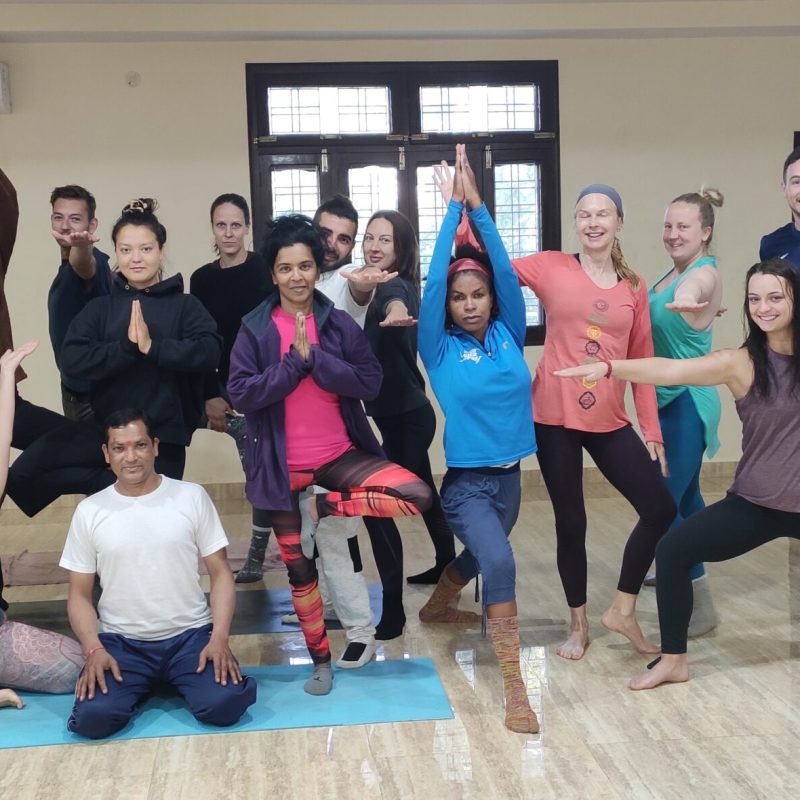
300 Hour Yoga Teacher Training in Rishikesh (India)
Duration: 28 Days
Module: Residential with Meal
Accommodation: Shared Room
Certification: Yoga Alliance USA
Course Fee: 1349 USD
Yoga Style: Hatha Yoga
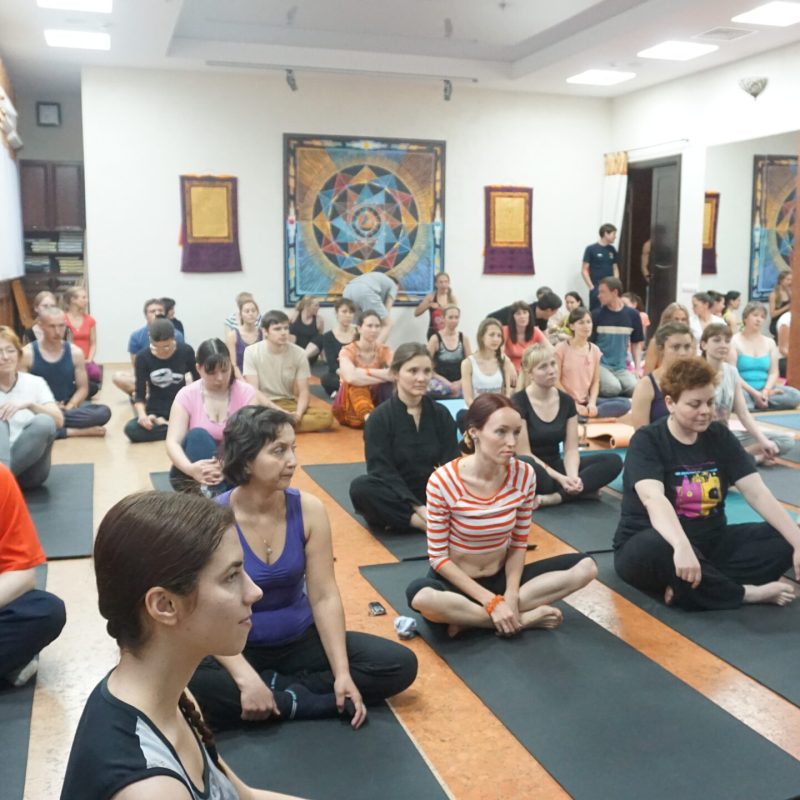
500 Hour Yoga Teacher Training in Rishikesh (India)
Duration: 55 Days
Module: Residential with Meal
Accommodation: Shared Room
Certification: Yoga Alliance USA
Course Fee: 2699 USD
Yoga Style: Hatha Yoga
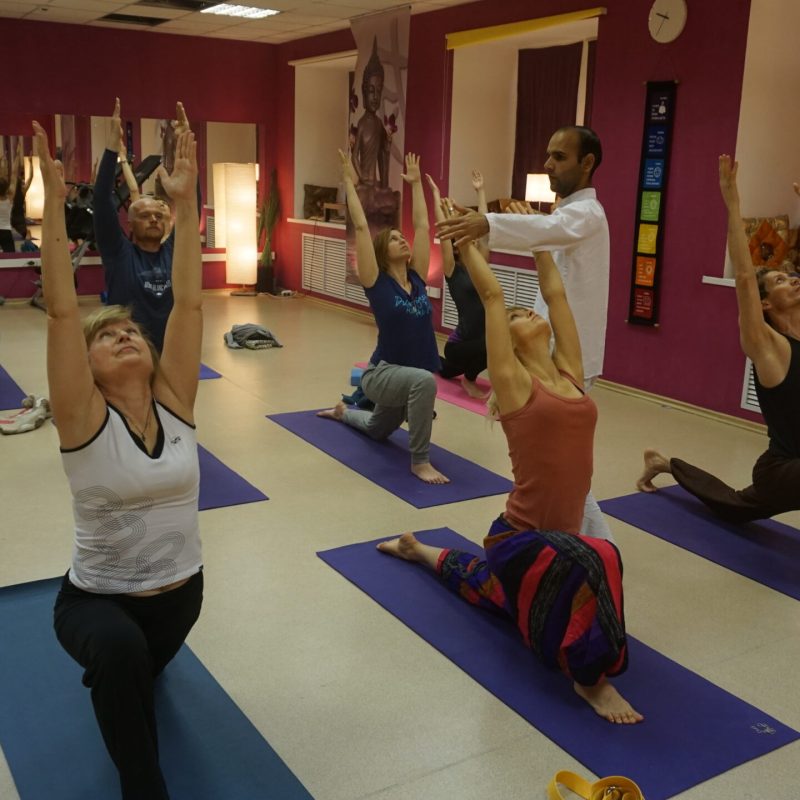
07 Days Yoga Retreats in Rishikesh (India)
Duration: 07 Days
Module: Residential with Meal
Accommodation: Shared Room
Certification: Yoga School
Course Fee: 499 USD
Style: Yoga Retreats

10 Days Yoga Retreats in Rishikesh (India)
Duration: 10 Days
Module: Residential with Meal
Accommodation: Shared Room
Certification: Yoga School
Course Fee: 649 USD
Style: Yoga Retreats
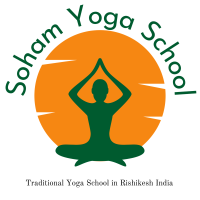
Nestled in Rishikesh, Soham Yoga School offers Yoga Alliance certified teacher training programs in Hatha and Ashtanga yoga styles. Emphasizing meditation, pranayama, “and” yoga philosophy, each course—from “100” to “500” hours—promises deep learning “and” personal growth. With comfortable accommodation “and” nutritious meals, graduates gain internationally recognized certifications “and” profound yoga knowledge.
